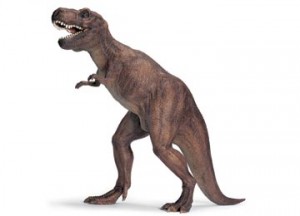Tyrannosaurus rex 100 Years Old
Our knowledge of Tyrannosaurus rex (tyrant lizard king) has certainly increased over the last twenty years or so as new more complete fossils are found. We now have a better understanding of the tyrannosaurid clade as more tyrannosaur fossils are discovered. For example, if the recently discovered Avityrannis jurassica turns out to be a true ancestor of T. rex then palaeontologists are going to have to revise the tyrannosaur family history, as Avityrannis would indicate this group evolving in southern Europe (Portugal) and not North America or Asia as previously thought. Even more startling Avityrannis has been found in Late Jurassic strata, pre-dating other early tyrannosaurus by something like 30 million years.
Looks like T. rex has a few surprises under its tail…
In total there are less than 30 Tyrannosaurus rex partial skeletons known. Barnum Brown had an incredible run of luck at the turn of the century locating several specimens from 1900 to 1906. It was from this collection that Henry Fairfield Osborn was able to name and describe this new dinosaur and the “King of the Tyrant Lizards” officially came to be.
Using the T. rex remains collected by Brown (most notably BM-R7995 and CM-9380), Osborn produced the first interpretation of this dinosaur.
Osborn used a human figure to depict the scale (a method he had used before in 1899 with a Diplodocus reconstruction). Note the comments made regarding the size of the forelimbs i.e. “the association of the small forelimbs is probably incorrect”. At the time it was thought that T. rex had forelimbs in the same proportion as the much better known Allosaurus fragilis. Scientists at the time could not believe that the tiny arm bones found in association with T. rex fossils actually belonged to this animal.
In 1906 a more complete T. rex skeleton was discovered (also by the incredibly skilfull; or should that be lucky Barnum Brown), enabling a second, more detailed drawing to be made.
Tyrannosaurus rex
To mark 100 years research on this the most famous and perhaps fiercest of all dinosaurs Schleich of Germany have introduced a new model Tyrannosaurus rex. This animal has been modelled in the more traditional pose, the so-called “kangaroo pose” with the heavy theropod tail resting on the ground. We had the chance to put some questions to the Schleich modellers about this new introduction, a Schleich Tyrannosaurus rex dinosaur model, to their range.
Schleich had withdrawn an earlier version of T. rex back in 2006 and replaced this with a modern interpretation of the tyrannosaur with a more horizontal posture. Tyrannosaurus rex is one of the company’s top selling models so it was thought that this animal justified the expense of designing two sculptures to make into models. The new modern looking tyrannosaurus (Everything Dinosaur model code: MOSA021 – Schleich number 16448) depicts the animal with its tail held clear of the ground. It was christened the “moving Tyrannosaurus rex“.
The More Animated “Moving T. rex” (MOSA021)
Picture courtesy of Everything Dinosaur
Click here to see Schleich T. rex dinosaur model: Dinosaur and Prehistoric Animal Models.
The latest T. rex model (Everything Dinosaur code MOSA031- Schleich number 16454) is due out in late September. We should have our first models in stock by September 15th. This new model depicts the animal in the traditional posture first postulated by Osborn 100 years ago. The model shows the sloping back and the tail tip resting on the ground. The latest fossil evidence has been used to produce the mottled skin effect on the model bringing some parts of this design right up to date but the posture is a homage to the very first interpretations of this huge meat-eater.
The Latest T. rex from Schleich (MOSA031)
Picture courtesy of Everything Dinosaur
Traditional T. rex Posture
The more traditional posture with the tail on the ground does have one huge advantage for the sculptors, modellers and designers. It is far easier to get a bipedal model such as this to stand upright when the tail is used as a third support. Perhaps Osborn had an eye on future merchandise sales when he produced the first scientific drawings of this animal.
Tyrannosaurus rex still has lots to tell us no doubt and you can bet more models of this famous extinct animal are bound to follow. One point about the new Tyrannosaurus from Schleich it is slightly larger than the very first T. rex model they produced. I believe this is in deference to the recent discovery by Keith Rigby of the allegedly bigger Tyrannosaurus. The skull measurements of this North American find indicate that it had a skull at least 30 cm longer than any other Tyrannosaurus rex. Is this a new Tyrannosaurus species as Rigby an his team claim (they have a nomen dubium of T. imperator) or is it just a really big example of Tyrannosaurus rex? We will have to wait until more research is done (and the legal battle over ownership and rights is resolved).








Leave A Comment